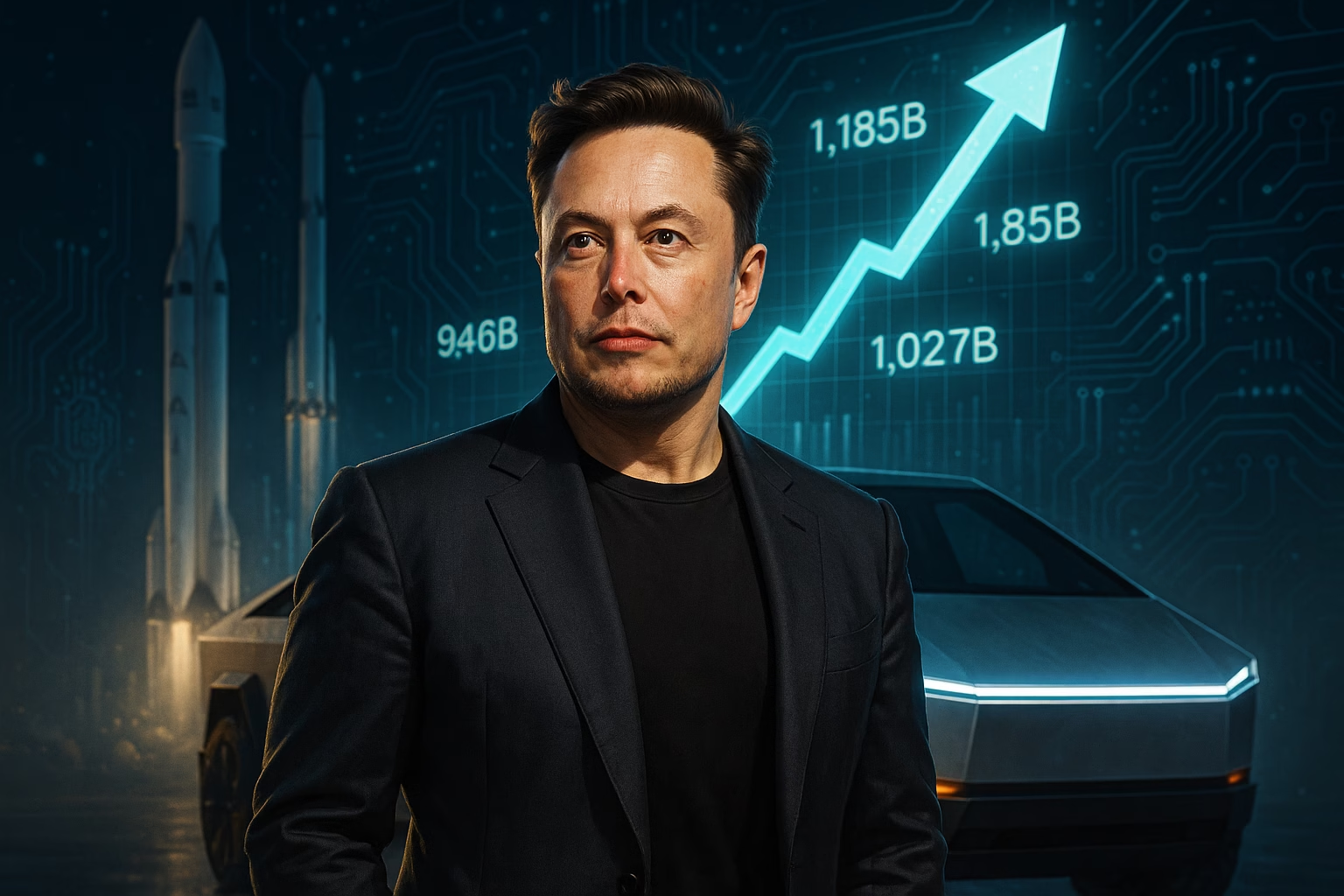In October 2025, Elon Musk became the first person ever to reach a net worth of $500 billion, according to Forbes. That milestone marks more than just personal wealth — it reflects the volatile epicenter of tech, automotive, and space industries, all deeply intertwined with Musk’s holdings.
In this blog, we break down:
- How Musk’s wealth is built (assets, equity, valuations)
- The trend dynamics — surges and dips — especially through 2025
- Tesla’s critical role and how its performance drives Musk’s fortunes
- Risks, criticisms, and what might come next
Let’s begin.
1. The Foundations of Musk’s Wealth
Major Assets & Stakes
- Tesla: Musk holds ~12–12.4% of shares in Tesla, making it a major lever for his net worth.
- SpaceX and Related Ventures: His 42% (approx.) stake in SpaceX, valued at $350–$400B (or more in some estimates), is another cornerstone.
- Other businesses & equity: xAI (merged with X), Neuralink, The Boring Company, and his family office (Excession LLC) also contribute.
Because much of Musk’s net worth is in equity rather than liquid assets, it’s highly sensitive to market valuations and investor sentiment.
2. Wealth Trend in 2025: Boom, Bust, Recovery
Early 2025: A Sharp Decline
At the start of 2025, Musk’s net worth experienced dramatic volatility:
- According to Cointelegraph, Elon Musk ’s net worth peaked near $486B in December 2024, but by March 2025, it had dropped to about $330B amid a steep fall in Tesla’s market value.
- Bloomberg/Benzinga reports that in 2025 alone, Musk lost over $61.2B in wealth as Tesla’s stock dipped and investor confidence wavered.
- Another source notes that Musk’s fortunes have bounced between $342B and $486B during 2025.
This volatility underscores the fragility when wealth is concentrated in single public equities.
Mid-to-Late 2025: Recovery & New Milestone
- Tesla’s stock rebound drove much of the upward swing. The stock is reported to have gained over 14% year-to-date in some periods, adding billions to Musk’s wealth.
- On October 1, 2025, Musk’s net worth topped $500B (briefly) on the Forbes Real-Time Billionaires list.
- However, Bloomberg’s index placed him slightly lower (e.g. $470B) based on end-of-day metrics, reflecting methodological differences in valuations.
So, 2025 has been a rollercoaster: a major drop followed by a dramatic recovery.
Click Here To Start Automated Futures Trading For Free
3. Tesla: The Engine Behind the Surge
Massive Market Cap Growth
- Tesla’s market cap is estimated at $1.53 trillion as of October 1, 2025, nearly doubling over the past year.
- That rise doesn’t just benefit retail shareholders — it directly multiplies Musk’s wealth because of his equity stake.
Factors Driving Tesla’s Rally
- Investor sentiment & confidence in leadership: Musk’s renewed focus on Tesla, share purchases, and renewed governance visibility helped boost confidence.
- Broader tech momentum: Tesla is often grouped with high-beta “Magnificent Seven” or tech-adjacent stocks, benefiting from cycles of capital flowing into growth/AI/EV bets.
- Operational performance: Vehicle deliveries, cost controls, battery advancements, and global expansion into new markets also matter, though public commentary is less transparent.
- Compensation proposals & incentives: A proposed $1 trillion compensation package (if certain performance metrics are met) could further inflate expectations around future upside.
Thus, much of Musk’s surge in wealth is a function of Tesla’s valuation trajectory.
4. Risks, Critiques & Volatility Factors
Heavy Exposure to One Asset
Because Musk’s wealth is not broadly diversified but heavily tied to Tesla and SpaceX, it’s exposed to:
- Market corrections or sector rotation — if capital flows out of high-multiple tech/EV stocks.
- Regulatory or geopolitical risk — for example, China EV competition, U.S. antitrust pressures, or subsidy changes.
- Leadership/PR risk — Musk’s political activity, social media statements, or management decisions often influence sentiment sharply.
Valuation Uncertainties
Valuing privately held firms like SpaceX or xAI involves assumptions about future funding, liquidity discounts, and market demand — estimates vary.
Methodology Differences
Different wealth trackers (Forbes, Bloomberg) use varying discount rates, update frequencies, and valuation models, which can lead to significant differences in reported net worth.
5. What’s Next? Projections & Observations
- Can Musk become a trillionaire? With proposed pay packages and valuation growth, it’s theoretically possible — if Tesla (and other ventures) exceed expectations.
- Sustainability of growth: Future gains hinge on continued scalability in EV, AI, space, energy — and avoiding regulatory backlash or market saturation.
- Wealth volatility remains: Expect wild swings. 2025 showed how a $100B+ swing is possible within months.
- Diversification might be key later: As Musk’s influence spreads over multiple sectors, his next leg of wealth growth might come less from Tesla alone and more from AI, infrastructure, or energy.
Conclusion
Elon Musk ’s journey to $500 billion net worth is not just a personal feat — it’s a magnifying lens into how wealth, technology, public markets, and leadership intersect. Tesla sits at the core of this story, serving as the lever that magnifies gains (and amplifies losses).
For investors and observers, the key takeaway is the massive leverage and risk concentration in tech-visionary wealth. Musk’s story tells us that in today’s world, fortunes can skyrocket — but they can also wobble dramatically.
Also Checkout: Automate TradingView Indicators with Tradovate Using PickMyTrade





